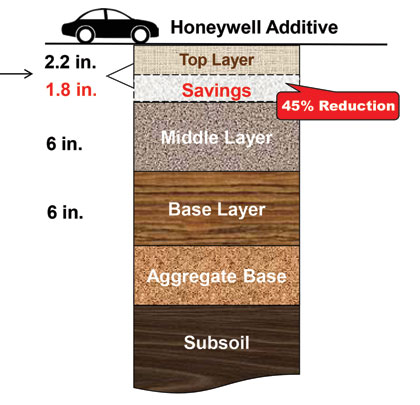A great deal of attention in the road industry is paid to improving pavement performance, while reducing construction and maintenance costs and road delays. The sooner you can open a road and the longer you can extend its lifetime, the better.
Next-generation additive technologies are giving contractors a unique opportunity to meet those needs more economically than ever before. This is especially important as the U.S. faces increasing pressure to solve a growing infrastructure crisis on limited funds.
The U.S. has 2.6 million miles of paved roads and highways, and 93 percent of those are surfaced with asphalt. The question becomes, how can we solve the challenge on limited budgets? The answer is two-fold. First, it will require new technologies, like next-generation additives, that help reduce costs without compromising performance. Second, it will require an innovation mindset to adopt new approaches and specifications.
A FLEXIBLE TECHNOLOGY
Today’s hot-mix asphalt (HMA) is carefully engineered to stand up to a variety of traffic loads and stresses, and consists of mineral aggregates, asphalt binders, and air voids. A new generation of additives, such as those from Honeywell, is designed to further improve performance.
Additives increase the contact length between rocks in the asphalt mix, resulting in better packing and distribution of the aggregate and improved load bearing properties. This structural advance improves road performance, making them less susceptible to rutting and cracking issues. Laboratory testing by the University of Wisconsin-Madison, and various paving projects, demonstrate:
- Up to a 30 percent improvement in rutting resistance
- Up to a 40 percent improvement in low-temperature cracking strength
- Excellent elastic recovery when mixed with SBS
These properties provide contractors with the flexibility to build longer lasting roads at currently specified thicknesses, significantly reducing maintenance costs over the lifetime of the road. By building better roads at a reduced thickness, contractors save on materials while maintaining performance.
Consequently, contractors can help Departments of Transportation (DOTs) stretch their dollars by paving more roadway miles on their initial construction budget, and by reducing subsequent maintenance costs—a competitive edge that can help earn more business.

A wearing layer of 4 in. can be reduced to 2.2 in., a reduction of 45%. This advantage enables budgets to be stretched even further, allowing more than 40% additional miles to be paved. Customers also realize up to 45% savings in HMA material costs, or $35,000/mile. In the U.S., where 32,000 lane-miles are paved in a calendar year, this frees enough funds to pave nearly 14,000 more lane-miles annually, or more than 40%.
REDUCE MAINTENANCE CYCLES AND COSTS
Next-generation additives are already saving money in maintenance costs by delivering improved strength and durability at currently specified thicknesses. For example, the combination of improved workability and a lower paving temperature requires less compaction time and fewer roller passes. This has enabled projects to be completed sooner, saving millions in fuel costs while lowering emissions and extending the paving season.
Importantly, the maintenance cycle can be cut by 50 percent. In a typical road design, industry models show that road maintenance is required every 6 to 7 years—or at least six maintenance cycles over 50 years. Next-generation additives can cut the maintenance cycles in half to just three, reducing road life costs by $186,000 per mile or 35 percent. This is money that can be spent on other road builds or maintenance.
STRETCH PAVING DOLLARS
When you add the capability to pave roads that are nearly half the thickness of today’s roads, but with equal or better durability, the picture gets even brighter. A wearing layer of 4 inches can be reduced to 2.2 inches, a reduction of 45 percent. This advantage enables budgets to be stretched even further, allowing more than 40 percent additional miles to be paved. Customers also realize up to 45 percent savings in HMA material costs, or $35,000 per mile.
In the U.S., where 32,000 lane-miles are paved in a calendar year, this frees enough funds to pave nearly 14,000 more lane-miles annually, or more than 40 percent.
AN INNOVATION MINDSET
The construction industry is rife with examples of reducing part thickness without sacrificing performance—from the use of high-performance plastics and composites to replace wood and metal, to specialty adhesives that replace screws and bolts. The paving industry can experience a similar step-change with next-generation asphalt additives, but an innovation mindset open to change is critical.
Unfortunately, today’s road specifications limit the opportunity to solve our infrastructure problems, specifying a single pavement thickness in most cases, regardless of the material. This is despite laboratory testing and industry-defining software, such as the AASHTOWare (American Association of State Highway and Transportation) Pavement ME Design, that suggest stronger materials can indeed deliver the same or better road performance at a lower thickness.
Consequently, design methods and specification protocols need to be updated. Road designers, for example, should be allowed to specify performance and thickness based on the strength of innovative new materials. Industry-defining software needs to be accepted as a design method, and large trials to prove the benefits of next-generation additives should be funded. ■
About The Author:
Cindy Kostelansky is the global business leader for asphalt at Honeywell. She holds a Ph.D. in inorganic chemistry from the University of North Carolina at Chapel Hill, and completed her postdoctoral research in catalyst development at the U.S. Naval Research Laboratory in Washington, D.C., where she received the National Academy of Sciences Post-Doctoral Research Fellowship. She holds four patents and is an active member of the Asphalt Institute, the National Asphalt Pavement Association, and other professional organizations.
_________________________________________________________________________
Modern Contractor Solutions, February 2015
Did you enjoy this article?
Subscribe to the FREE Digital Edition of Modern Contractor Solutions magazine.



